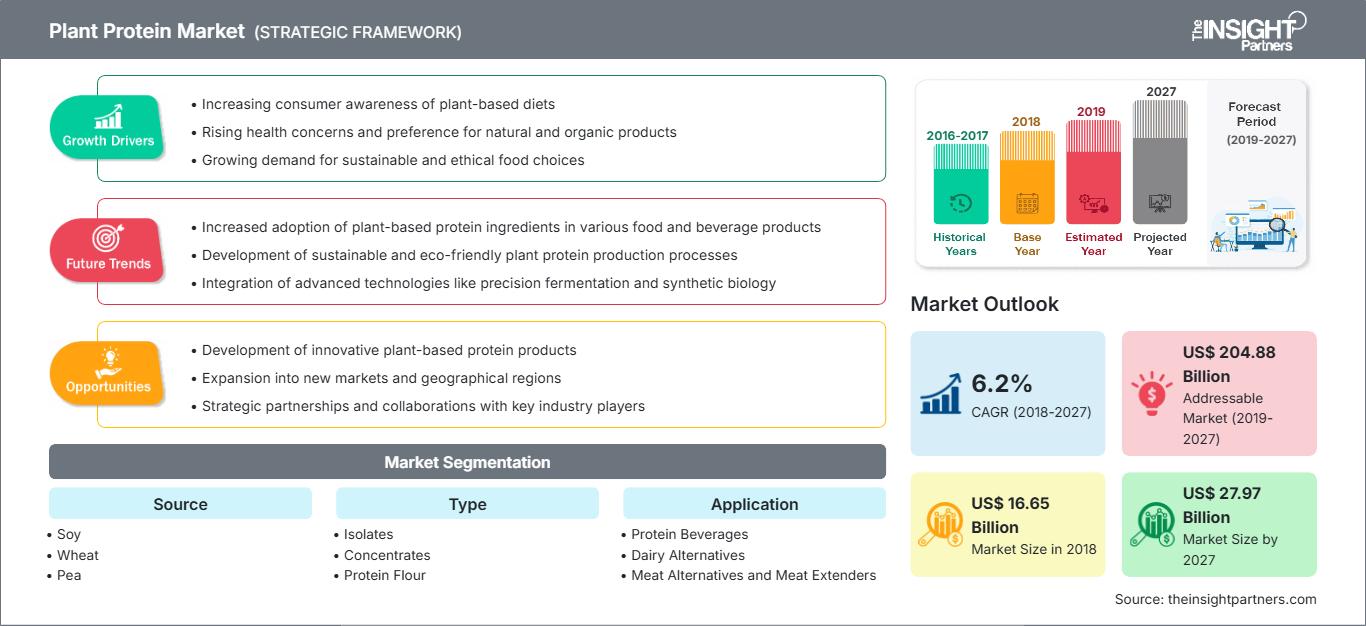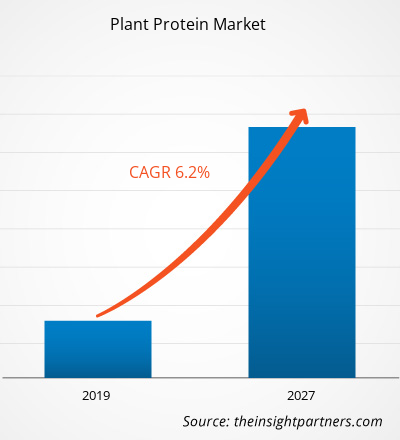식물성 단백질 시장은 2018년 166억 5,360만 달러 규모였으며, 2027년에는 279억 6,590만 달러에 이를 것으로 예상됩니다. 2019년부터 2027년까지 연평균 성장률(CAGR) 6.2%로 성장할 것으로 예상됩니다.
단백질은 인체에 필수적인 필수 영양소로, 아미노산으로 구성되어 있습니다. 식물성 단백질은 콩, 밀, 완두콩, 견과류, 씨앗 등 다양한 식물성 원료에서 얻을 수 있습니다. 렌틸콩, 병아리콩, 땅콩, 아몬드, 스피룰리나, 퀴노아, 치아씨드 등 다양한 식물성 원료는 풍부한 단백질을 제공합니다. 식물성 단백질은 칼로리가 낮아 체중 감량을 위해 동물성 단백질을 대체하여 섭취할 수 있습니다. 식물성 식품에 대한 수요 증가와 고단백 식품에 대한 소비자 관심 증가는 전 세계적으로 식물성 단백질 시장 성장을 촉진하는 주요 요인입니다.
아시아 태평양 지역의 식물성 단백질 시장 성장은 예측 기간 동안 가장 높은 연평균 성장률(CAGR)을 기록할 것으로 예상됩니다. 이 지역의 식물성 단백질 시장 성장은 주로 가처분소득 증가에 기인하며, 변화하는 라이프스타일은 아시아 태평양 지역의 식물성 단백질 시장 성장을 견인하는 주요 요인입니다. 중국, 인도, 일본 등 선진국과 개발도상국의 식음료 산업이 빠르게 성장하면서 식물성 단백질은 단백질 음료, 유제품 대체 식품, 육류 대체 식품, 단백질 바 등의 제품에 광범위하게 사용되기 때문에 제조업체에게 막대한 시장 기회를 제공합니다.
인도, 중국, 호주 등 선진국과 개발도상국의 사람들의 가처분소득 증가는 이 지역의 식물성 단백질 수요 급증으로 이어졌습니다.
요구 사항에 맞게 이 보고서를 사용자 정의하십시오.
이 보고서의 일부, 국가 수준 분석, Excel 데이터 팩을 포함하여 모든 보고서에 대한 사용자 정의를 무료로 받을 수 있을 뿐만 아니라 스타트업 및 대학을 위한 훌륭한 제안 및 할인을 이용할 수 있습니다
식물성 단백질 시장: 전략적 통찰력

- 이 보고서의 주요 주요 시장 동향을 확인하세요.이 무료 샘플에는 시장 동향부터 추정 및 예측에 이르기까지 데이터 분석이 포함됩니다.
이 보고서의 일부, 국가 수준 분석, Excel 데이터 팩을 포함하여 모든 보고서에 대한 사용자 정의를 무료로 받을 수 있을 뿐만 아니라 스타트업 및 대학을 위한 훌륭한 제안 및 할인을 이용할 수 있습니다
식물성 단백질 시장: 전략적 통찰력

- 이 보고서의 주요 주요 시장 동향을 확인하세요.이 무료 샘플에는 시장 동향부터 추정 및 예측에 이르기까지 데이터 분석이 포함됩니다.
시장 분석: 단백질이 풍부한 식품에 대한 소비자 인식 제고, 식물성 단백질 시장 성장 촉진
단백질은 세포 복구를 돕고 바이러스와 박테리아로부터 신체를 보호하여 분자를 몸 전체로 운반하는 데 중요한 역할을 합니다. 또한 어린이, 청소년, 임산부의 적절한 성장과 발달을 촉진합니다.
다양한 연구에 따르면 단백질이 풍부한 식단은 근육량과 근력을 증가시키고 체중 관리 또는 감량 프로그램 중 근육 손실을 예방하는 데 도움이 됩니다.
단백질을 더 많이 섭취하는 사람들은 골밀도 유지가 더 잘되고 골다공증 및 골절 위험이 훨씬 낮아지는 경향이 있습니다. 단백질 섭취가 증가하면 신진대사가 촉진되어 많은 칼로리를 소모하게 됩니다. 이는 적절한 체중 관리 및 감량에 도움이 됩니다. 단백질의 이러한 이점은 시중에서 판매되는 단백질이 풍부한 식품 및 음료에 소비자들을 끌어들이고 있으며, 이는 전 세계적으로 식물성 단백질에 대한 수요를 크게 증가시킵니다.
단백질이 풍부한 식품은 식품 및 음료 산업의 가장 강력한 트렌드 중 하나로 여겨집니다. 식품의 단백질 트렌드에 발맞춰 식음료 제조업체들은 영양 식품을 개발하고 있습니다. 단백질이 풍부한 식품 섭취를 통해 체중 감량, 노화 방지 및 기타 건강 관련 문제를 해결하는 효과적인 방법에 대한 소비자 인식이 높아짐에 따라 식물성 단백질 수요가 증가하고 있습니다. 또한, 건강 및 웰빙 트렌드의 확산으로 지난 몇 년간 기능성 및 강화 식품과 음료에 대한 수요가 크게 증가했습니다. 따라서 단백질이 풍부한 식품에 대한 소비자 인식 향상은 식물성 단백질 시장 성장을 촉진할 것으로 예상됩니다.
공급원 기반 분석
식물성 단백질 시장은 공급원을 기준으로 대두, 밀, 완두콩 등으로 분류됩니다. 대두 부문은 2018년 시장 점유율 1위를 차지했지만, 예측 기간 동안 완두콩 부문이 가장 높은 연평균 성장률을 기록할 것으로 예상됩니다. 분리대두단백은 단백질 함량이 최소 90%인 고도로 정제된 대두 단백질입니다. 탈지 대두분에서 지방과 탄수화물을 포함한 대부분의 비단백질 성분이 제거되어 만들어집니다. 대두 단백질 분말은 탈지 대두 플레이크를 알코올이나 물로 세척하여 당과 식이섬유를 제거한 후, 탈수 과정을 거쳐 분말 형태로 만들어집니다. 대두 단백질 분말은 유아용 조제분유뿐만 아니라 다양한 육류 및 유제품 대체 식품을 만드는 데 사용됩니다. 농축 대두 단백질은 일반적으로 70%의 대두 단백질을 함유하고 있으며, 기본적으로 수용성 탄수화물이 제거된 탈지 대두분입니다. 이 단백질은 껍질을 벗기고 탈지한 대두에서 탄수화물 일부를 제거하여 만들어집니다. 대두분은 대두를 고운 분말로 갈아서 만듭니다.
유형별 분석
식물성 단백질 시장은 유형에 따라 분리 단백질, 농축 단백질, 단백질 가루로 구분됩니다. 농축물 부문은 2018년 가장 큰 시장 점유율을 차지했습니다. 식물성 단백질 농축물은 콩, 밀, 완두콩, 퀴노아, 귀리, 콩, 견과류 등 다양한 원료에서 단백질을 추출하여 생산됩니다. 일반적으로 60~80%의 단백질을 함유하고 있으며, 나머지 20~40%는 지방과 탄수화물로 구성됩니다. 농축 식물성 단백질은 단백질 파우더 중 가공이 가장 적게 된 형태입니다. 농축된 형태의 식물성 단백질은 체내 흡수율이 높아 격렬한 운동 후 근육 회복에 도움을 줍니다. 따라서 식물성 단백질 농축물의 쉬운 구매 가능성과 식물성 단백질 분리물보다 저렴한 가격이 시장 성장의 주요 요인입니다. 식물성 단백질 농축물은 일반적으로 가장 저렴한 선택이지만, 다른 성분을 더 많이 함유하고 있어 식물성 단백질 분리물보다 단백질 함량이 낮습니다. 이러한 추가 성분에는 지방, 콜레스테롤, 유당, 글루텐 등이 포함될 수 있습니다. 지방 섭취를 제한하거나 소화 기관이 예민한 소비자는 식물성 단백질 농축물을 피해야 합니다.
응용 분야 기반 통찰력
식물성 단백질 시장은 유형에 따라 단백질 음료, 유제품 대체 식품, 육류 대체 식품 및 육류 증량제, 단백질 바, 제빵 및 기타 응용 분야로 세분화됩니다. 육류 대체 식품 및 육류 증량제 부문은 2018년 시장 점유율이 가장 높았습니다. 육류 대체 제품에는 두부, 템페, 조직화 식물성 단백질, 세이탄, 쿼른 등이 있습니다. 이러한 제품은 가금류, 육류 및 생선 제품과 유사한 맛, 외관 및 질감을 가지고 있습니다. 곡물 및 식물성 재료를 사용하여 제조되어 동물성 단백질과 미네랄(특히 칼슘)을 대체하며, 콜레스테롤 수치 감소, 갱년기 장애 및 기타 관련 질환 예방에 도움이 됩니다. 식물성 단백질은 육류 대체 식품 생산에 널리 사용됩니다. 콩과 식물은 육류 대체 식품으로 사용할 수 있는 저렴한 식물성 단백질 공급원입니다. 콩은 또한 육류 대체 식품 생산의 주요 공급원 중 하나입니다. 완두콩 단백질 분리물은 Daiya, Gardein, Ben & Jerry's, Beyond Meat, Just Mayo, Ripple Foods 등 육류 대체 식품 제조업체에서 주로 사용합니다. 따라서 육류 대체 식품에 대한 수요와 생산 급증은 식물성 단백질에 대한 수요 증가로 이어집니다. 소비자들의 건강 우려 증가와 비건 식품에 대한 선호도 증가로 육류 대체 식품에 대한 수요가 증가하고 있습니다. 또한, 육류 및 육류 가공품 소비 증가로 인한 비만율 증가는 육류 대체 식품에 대한 소비자의 선호도를 증가시켰습니다.
식물성 단백질 시장에서 활동하는 몇몇 업체로는 Archer Daniels Midland Company, Axiom Foods, Inc., Burcon NutraScience Corporation, Cargill, Incorporated, EI Du Pont De Nemours and Company, Glanbia plc, Ingredion Incorporated, Kerry Group, Koninklijke DSM NV, Roquette Frères 등이 있습니다. 주요 기업들은 고객 기반을 확대하고 글로벌 시장에서 상당한 점유율을 확보하기 위해 합병 및 인수, 연구 개발 전략을 실행하며, 이를 통해 전 세계적으로 브랜드 이름을 유지합니다.
식물성 단백질 시장
식물성 단백질 시장
The Insight Partners의 분석가들은 예측 기간 동안 식물성 단백질 시장에 영향을 미치는 지역별 동향과 요인들을 면밀히 분석했습니다. 이 섹션에서는 북미, 유럽, 아시아 태평양, 중동 및 아프리카, 그리고 중남미 지역의 식물성 단백질 시장 세분화 및 지역별 분포도 살펴봅니다.
식물성 단백질 시장 보고서 범위
| 보고서 속성 | 세부 |
|---|---|
| 시장 규모 2018 | US$ 16.65 Billion |
| 시장규모별 2027 | US$ 27.97 Billion |
| 글로벌 CAGR (2018 - 2027) | 6.2% |
| 이전 데이터 | 2016-2017 |
| 예측 기간 | 2019-2027 |
| 다루는 세그먼트 |
By 원산지
|
| 포함된 지역 및 국가 | 북미
|
| 시장 선도 기업 및 주요 회사 프로필 |
|
식물성 단백질 시장 참여자 밀도: 비즈니스 역학에 미치는 영향 이해
식물성 단백질 시장은 소비자 선호도 변화, 기술 발전, 그리고 제품의 효능에 대한 인식 제고 등의 요인으로 인한 최종 사용자 수요 증가에 힘입어 빠르게 성장하고 있습니다. 수요가 증가함에 따라 기업들은 제품 라인업을 확장하고, 소비자 니즈를 충족하기 위한 혁신을 추진하며, 새로운 트렌드를 적극 활용하고 있으며, 이는 시장 성장을 더욱 가속화하고 있습니다.

- 을 얻으세요 식물성 단백질 시장 주요 주요 플레이어 개요
보고서 스포트라이트
- 식물성 단백질 시장의 진보적인 산업 동향은 플레이어가 효과적인 장기 전략을 개발하는 데 도움이 됩니다.
- 선진국과 개발도상국 시장에서 채택한 사업 성장 전략
- 2018년부터 2027년까지 식물성 단백질 시장에 대한 정량적 분석
- 식물성 단백질에 대한 글로벌 수요 추정
- 산업에서 활동하는 구매자와 공급자의 효율성을 보여주기 위한 PEST 분석
- 경쟁적인 시장 시나리오를 이해하기 위한 최근 개발
- 시장 동향 및 전망과 함께 식물성 단백질 시장 성장을 주도하고 제한하는 요소
- 상업적 관심을 뒷받침하고 시장 성장을 이끄는 시장 전략을 강조하여 의사 결정 프로세스 지원
- 다양한 노드에서의 식물성 단백질 시장 규모
- 시장과 식물성 단백질 산업에 대한 자세한 개요 및 세분화 역학
- 성장 가능성이 유망한 다양한 지역의 식물성 단백질 시장 규모
- 과거 분석(2년), 기준 연도, CAGR을 포함한 예측(7년)
- PEST 및 SWOT 분석
- 시장 규모 가치/거래량 - 글로벌, 지역, 국가
- 산업 및 경쟁 환경
- Excel 데이터세트
최근 보고서
사용 후기
구매 이유
- 정보에 기반한 의사 결정
- 시장 역학 이해
- 경쟁 분석
- 고객 인사이트
- 시장 예측
- 위험 완화
- 전략 기획
- 투자 타당성 분석
- 신흥 시장 파악
- 마케팅 전략 강화
- 운영 효율성 향상
- 규제 동향에 발맞춰 대응




















 무료 샘플 받기 - 식물성 단백질 시장
무료 샘플 받기 - 식물성 단백질 시장